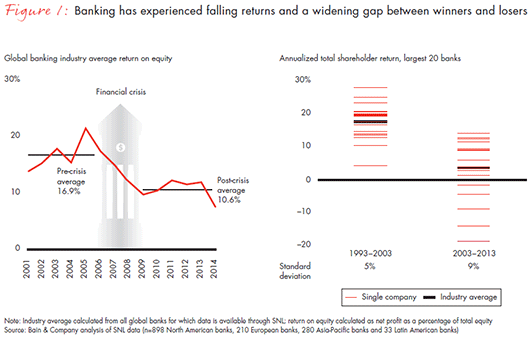The return of corporate strategy in banking

For many years, corporate strategy languished in banking circles. During the go-go 1990s and most of the 2000s, too many bankers pursued indiscriminate growth, had a broad appetite for risk and diversified their portfolios without worrying enough about controlling costs or staking out distinctive positions in the eyes of customers.
Then, the 2008 financial crisis caused an abrupt about-face from growth to survival. Many bankers wielded blunt restructuring tools to take out costs and deleverage their balance sheets in order to meet regulators’ capital adequacy requirements. While most of these measures were necessary, they certainly did not set the stage for future growth. The majority of banks relied on the same tactics of cost takeout, branch network pruning and performance improvement over the past five years, yet the industry’s return on equity dropped by 6 percentage points since before the crisis, and continues to decline (see Figure 1).
Then, the 2008 financial crisis caused an abrupt about-face from growth to survival. Many bankers wielded blunt restructuring tools to take out costs and deleverage their balance sheets in order to meet regulators’ capital adequacy requirements. While most of these measures were necessary, they certainly did not set the stage for future growth. The majority of banks relied on the same tactics of cost takeout, branch network pruning and performance improvement over the past five years, yet the industry’s return on equity dropped by 6 percentage points since before the crisis, and continues to decline (see Figure 1).
The times demand that banks relearn strategy. Banks’ sources of revenue have come under pressure: Credit growth has slowed as consumers and businesses have deleveraged, net interest margins have been squeezed, and fee income has come under pressure due to increased competition and consumer watchdogs’ focus on unfair practices. At the same time, new digitally based entrants with disruptive business models, such as eToro and Kabbage, have been attacking lazy profit pools and taking share from incumbent banks. Several waves of regulation have introduced ever stricter and higher capital requirements, reducing banks’ own balance sheet leverage.
The new macro and competitive environment means that banks have to adapt through more disciplined strategy. At some banks, what passes for strategy, in fact consists of the pursuit of quarterly profit targets. A long-term growth strategy, by contrast, often means enduring some pain over the short term and explaining to shareholders why it takes time to deliver results.
To be sure, many challenges today—including low interest rates, high nonperforming loans in some countries and a regulatory backlash in many regions—have some element of cyclicality. Observers taking an extreme position could argue that banks in southern Europe will continue to lag no matter what their strategy is and that US banks can expect stronger growth once interest rates rise. Bankers who buy the cyclical explanation might feel as though they have limited options or should not make material changes.
We believe that cyclical effects, though real, do not present a complete picture. Some banks perform better than others in the same conditions, and the winners over long periods manage the structural as well as the cyclical elements.
Consider that the gap in total shareholder return between the best and worst of the 20 largest banks worldwide has widened from a 5% standard deviation from the average return between 1993 and 2003 to 9% over the 2003–2013 period. Clearly, different business choices led to different financial outcomes.
For many banks, then, a last call for creating a sustainable advantage is approaching. They will need to stretch dormant strategy muscles at the enterprise level. This goes well beyond ranking current businesses based on their financial contribution, because that exercise cannot predict what will deliver future returns.
The old, blunt strategic playbook took a resource-led approach to the portfolio that ranked businesses within existing constraints of risk, capital and liquidity, leading to short-term (one- to two-year) planning. A more effective approach to strategy defines decisions that can distinguish the bank from competitors in the eyes of customers and that allow the bank to beat competitors through cost leadership, superior customer service or other means. This approach takes a three- to five-year planning horizon, with a target portfolio that determines risk, capital and liquidity boundaries.
Writing a new playbook requires making real choices
Any strategy should take into account the starting point and the customer, competitive, technological and regulatory trends affecting a bank and its markets. It should also equip the bank to manage through financial market and economic cycles, being explicit about the risk exposures desired and how to adjust those exposures throughout the cycle. Accomplishing both goals entails defining a much broader set of options than most banks have considered regarding their business portfolio, risk appetite and capital allocation.
Strategy should define the attractive markets and whether a bank can develop a strong and sustainable position in those markets so that it can build a few distinctive assets and capabilities that set it apart. Differentiation comes not from baseline steps such as moving activities online but rather by sculpting features that will induce customers to take out a mortgage or invest their wealth with one bank over its competitors.
Making choices about what type of bank to become is a central issue for all banks today. Bain’s analysis of 250 banks globally shows that only 1 in 9 are sustained value creators—we define this group as banks that beat the competition on revenue and earnings growth over the 10-year period, while delivering total shareholder return greater than the cost of capital.
In our sampling, 65% of the sustained value creators (by number of banks) are local or regional, multi-category banks. By contrast, only 4% of sustained value creators fit the global universal model, which is a smaller share than the 7% of total banks that fit the global model (see Figure 2). Most of the global universal banks extended their footprint so broadly that they now have a long tail of subscale countries or products that don’t yield leadership economics. For years, given positive macroeconomic trends and reasonable growth in emerging markets, global universal banks were not required to prove that synergies of scope, scale and funding exceeded the potential drawbacks of complexity and control challenges. However, slower economic growth, increasingly sophisticated local competitors and recent regulatory changes have imposed significant penalties for being global and universal. That forces global universal banks to reassess the value of this model.
The new macro and competitive environment means that banks have to adapt through more disciplined strategy. At some banks, what passes for strategy, in fact consists of the pursuit of quarterly profit targets. A long-term growth strategy, by contrast, often means enduring some pain over the short term and explaining to shareholders why it takes time to deliver results.
To be sure, many challenges today—including low interest rates, high nonperforming loans in some countries and a regulatory backlash in many regions—have some element of cyclicality. Observers taking an extreme position could argue that banks in southern Europe will continue to lag no matter what their strategy is and that US banks can expect stronger growth once interest rates rise. Bankers who buy the cyclical explanation might feel as though they have limited options or should not make material changes.
We believe that cyclical effects, though real, do not present a complete picture. Some banks perform better than others in the same conditions, and the winners over long periods manage the structural as well as the cyclical elements.
Consider that the gap in total shareholder return between the best and worst of the 20 largest banks worldwide has widened from a 5% standard deviation from the average return between 1993 and 2003 to 9% over the 2003–2013 period. Clearly, different business choices led to different financial outcomes.
For many banks, then, a last call for creating a sustainable advantage is approaching. They will need to stretch dormant strategy muscles at the enterprise level. This goes well beyond ranking current businesses based on their financial contribution, because that exercise cannot predict what will deliver future returns.
The old, blunt strategic playbook took a resource-led approach to the portfolio that ranked businesses within existing constraints of risk, capital and liquidity, leading to short-term (one- to two-year) planning. A more effective approach to strategy defines decisions that can distinguish the bank from competitors in the eyes of customers and that allow the bank to beat competitors through cost leadership, superior customer service or other means. This approach takes a three- to five-year planning horizon, with a target portfolio that determines risk, capital and liquidity boundaries.
Writing a new playbook requires making real choices
Any strategy should take into account the starting point and the customer, competitive, technological and regulatory trends affecting a bank and its markets. It should also equip the bank to manage through financial market and economic cycles, being explicit about the risk exposures desired and how to adjust those exposures throughout the cycle. Accomplishing both goals entails defining a much broader set of options than most banks have considered regarding their business portfolio, risk appetite and capital allocation.
Strategy should define the attractive markets and whether a bank can develop a strong and sustainable position in those markets so that it can build a few distinctive assets and capabilities that set it apart. Differentiation comes not from baseline steps such as moving activities online but rather by sculpting features that will induce customers to take out a mortgage or invest their wealth with one bank over its competitors.
Making choices about what type of bank to become is a central issue for all banks today. Bain’s analysis of 250 banks globally shows that only 1 in 9 are sustained value creators—we define this group as banks that beat the competition on revenue and earnings growth over the 10-year period, while delivering total shareholder return greater than the cost of capital.
In our sampling, 65% of the sustained value creators (by number of banks) are local or regional, multi-category banks. By contrast, only 4% of sustained value creators fit the global universal model, which is a smaller share than the 7% of total banks that fit the global model (see Figure 2). Most of the global universal banks extended their footprint so broadly that they now have a long tail of subscale countries or products that don’t yield leadership economics. For years, given positive macroeconomic trends and reasonable growth in emerging markets, global universal banks were not required to prove that synergies of scope, scale and funding exceeded the potential drawbacks of complexity and control challenges. However, slower economic growth, increasingly sophisticated local competitors and recent regulatory changes have imposed significant penalties for being global and universal. That forces global universal banks to reassess the value of this model.


